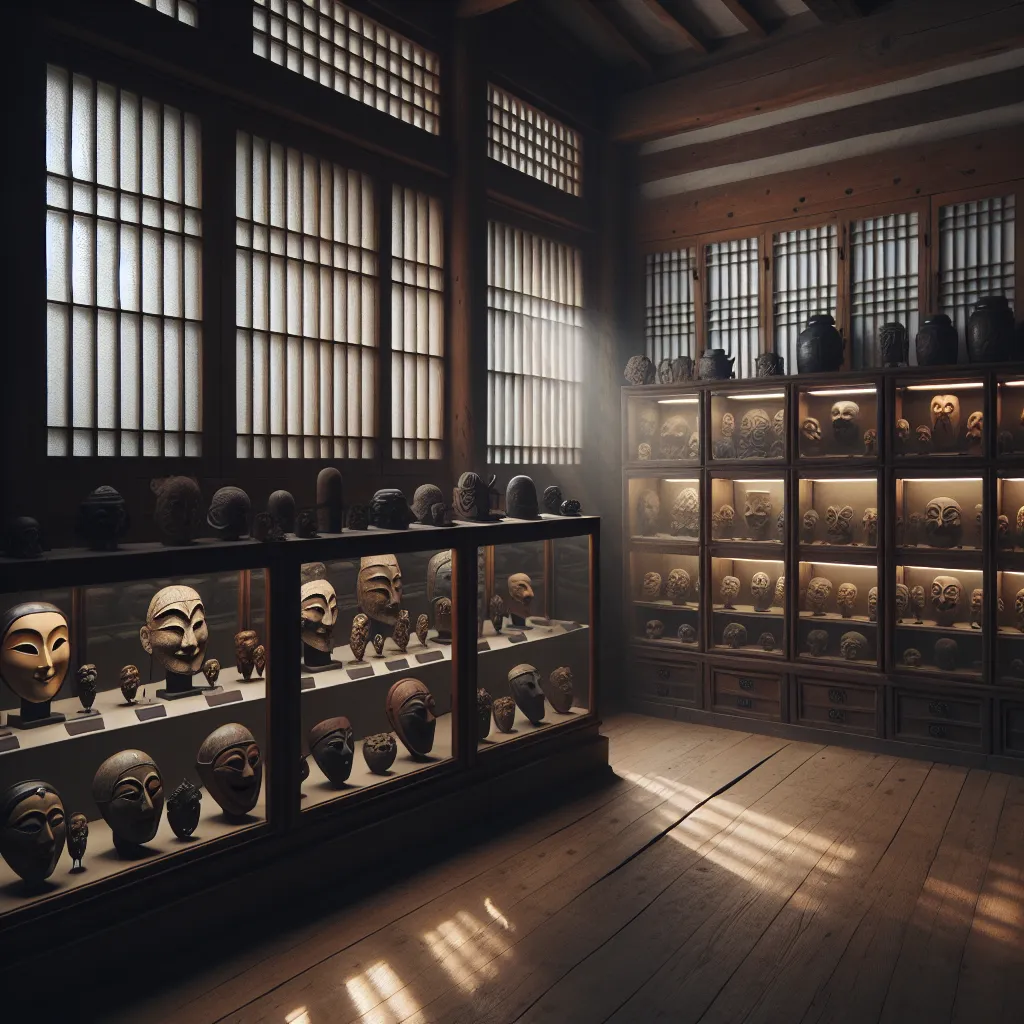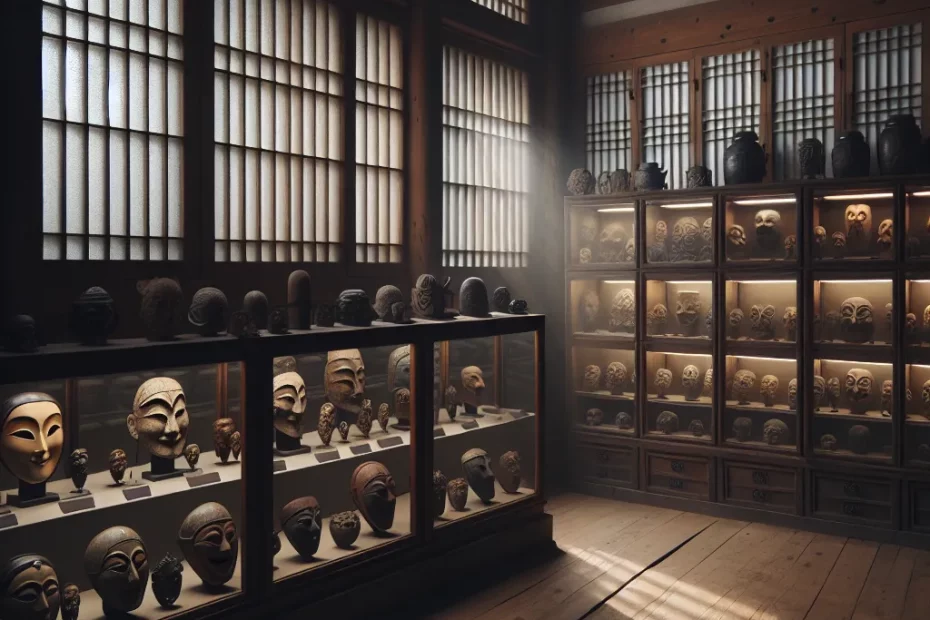As you step into the Andong Hahoe Mask Museum, you are transported back in time to discover the rich history and cultural significance of Korean masks. The museum offers a fascinating journey into the world of traditional mask-making, showcasing the evolution of techniques and the symbolism behind each intricate design. From the origins of Korean masks to the unique features of Hahoe masks, every detail tells a story of tradition and artistry that has been passed down through generations. Explore the museum and unravel the mysteries behind these captivating masks that have played a significant role in Korean culture for centuries.

The Origin of Korean Masks
In the realm of traditional Korean culture, masks hold a significant place, embodying a rich history and cultural heritage that dates back centuries. These masks, known as “tal” in Korean, have been an integral part of various rituals, performances, and ceremonies, each carrying its own unique symbolism and meaning. Let’s delve into the fascinating origins of Korean masks and unravel the intricate tapestry of history woven into these captivating cultural artifacts! 🎭
Korean masks: A Blend of Tradition and Culture
Korean masks have a diverse range of origins, with influences stemming from shamanistic practices, folk beliefs, and theatrical performances. The earliest records of masks in Korea can be traced back to the Three Kingdoms period (57 BC – 668 AD), where masks were used in shamanistic rituals to ward off evil spirits and bring blessings to the community. These early masks were crafted from materials such as wood, paper, and gourds, each meticulously designed to represent various deities, animals, and mythical creatures.
The Evolution of Masks in Korean Culture
As time progressed, the use of masks in Korea expanded beyond shamanistic rituals to encompass a wide array of cultural practices. During the Goryeo Dynasty (918–1392), masks became an essential element in traditional Korean dance dramas, known as “talchum,” where performers would don colorful masks to portray characters from folklore, history, and everyday life. These performances not only entertained audiences but also served as a means of social commentary and satire, reflecting the political and social issues of the time.
The Iconic Hahoe Mask
One of the most iconic Korean masks is the “Hahoe mask,” which takes its name from the Hahoe Folk Village in Andong, South Korea. These masks, characterized by their exaggerated features and intricate designs, are believed to bring good fortune and drive away evil spirits. The Hahoe mask tradition has been passed down through generations, with master craftsmen meticulously carving each mask by hand, preserving the ancient techniques and artistic styles unique to this cultural heritage.
Legacy and Modern Influence
In addition to their cultural significance, Korean masks also play a vital role in modern society, with contemporary artists and performers incorporating traditional mask-making techniques into their work. The Andong Hahoe Mask Museum stands as a testament to the enduring legacy of Korean masks, showcasing a diverse collection of masks from different regions and time periods, offering visitors a glimpse into the intricate craftsmanship and artistic expression embedded in these cultural treasures.
Preserving Tradition and Creativity
Through the exploration of the origin of Korean masks, we gain a deeper appreciation for the intricate artistry, cultural symbolism, and historical significance encapsulated within these captivating artifacts. As we continue to preserve and celebrate this rich cultural heritage, Korean masks serve as a timeless reminder of the enduring legacy of tradition and creativity that continues to inspire and captivate audiences around the world. 🌟
Evolution of Mask Making Techniques
Mask making has been an integral part of Korean culture for centuries, with a rich history that continues to fascinate people around the world. The evolution of mask making techniques in Korea is a testament to the creativity and craftsmanship of the artisans who have dedicated their lives to this art form.
Traditional Korean Masks
Traditional Korean masks, known as “tal,” were originally used in shamanistic rituals and performances to ward off evil spirits and bring good fortune. These masks were handcrafted using materials such as wood, paper, and clay, and were often painted in vibrant colors to represent various characters from Korean folklore.
Advancements in Techniques
As time progressed, new techniques and materials were introduced, leading to the development of more intricate and detailed masks. Artisans began incorporating techniques such as carving, molding, and painting to create masks that were not only visually stunning but also culturally significant.
Introduction of Hanji
One of the most notable advancements in mask making techniques was the introduction of hanji, traditional Korean paper made from mulberry bark. Hanji allowed artisans to create lightweight yet durable masks that could be intricately painted and decorated. This innovation revolutionized the way masks were made and opened up new possibilities for artistic expression.
Experimentation with Painting Techniques
In addition to hanji, artisans also started experimenting with new painting techniques, such as using natural dyes and pigments to create more vibrant colors. The use of gold leaf and other decorative elements further enhanced the beauty and authenticity of Korean masks.
Modern Technological Influence
Today, modern technology has also played a role in the evolution of mask making techniques. 3D printing, for example, has enabled artisans to create highly detailed and precise masks with intricate designs that were once impossible to achieve by hand. This marriage of traditional craftsmanship with modern innovation has pushed the boundaries of mask making to new heights.
Andong Hahoe Mask Museum
The Andong Hahoe Mask Museum stands as a testament to the rich history and evolution of Korean mask making techniques. By exploring the exhibits and learning about the intricate processes involved in creating these cultural treasures, visitors can gain a deeper appreciation for the artistry and craftsmanship that have been passed down through generations.
In conclusion, the evolution of mask making techniques in Korea is a story of innovation, creativity, and cultural preservation. From the humble beginnings of traditional tal masks to the intricate masterpieces of today, Korean masks continue to captivate audiences with their beauty and symbolism. Visit the Andong Hahoe Mask Museum to discover the fascinating history of Korean masks and witness firsthand the evolution of this ancient art form! 🎭🖌️🌟
Symbolism Behind Korean Masks
In the realm of Korean culture, masks hold a profound significance that transcends mere artistic expression. These masks, with their intricate designs and vibrant colors, serve as powerful symbols representing various facets of Korean history, mythology, and societal norms. From the jovial Hahoe masks to the fearsome Tal masks, each piece encapsulates a unique narrative that speaks volumes about the rich tapestry of Korean heritage.
Historical Significance
Korean masks have a long history dating back to ancient times, where they were used in traditional rituals, performances, and ceremonies. These masks were not just decorative items but were believed to possess spiritual powers, serving as a medium to communicate with gods and ancestors. The intricate carvings and elaborate designs on the masks often depicted characters from folklore, legends, and historical events, preserving the cultural heritage of Korea.
Symbolism of Colors
In Korean mask symbolism, colors play a crucial role in conveying deeper meanings. For instance, the color white symbolizes purity, innocence, and spirituality, often seen in masks representing virtuous characters or spirits. On the other hand, red signifies passion, courage, and vitality, commonly found in masks portraying warriors or deities associated with power and strength. The careful selection of colors in Korean masks adds layers of symbolism and enhances the storytelling aspect of each piece.
Representation of Emotions
Korean masks are not merely static objects but dynamic representations of a wide range of emotions. The exaggerated expressions, from wide grins to fierce scowls, capture the essence of human emotions in a vivid manner. These masks were used in traditional performances like mask dances to convey emotions such as joy, sorrow, anger, and love, creating a visual spectacle that resonated with audiences on a profound level.
Cultural Preservation
The significance of Korean masks goes beyond their artistic value; they serve as a link to the past, preserving traditions and cultural practices that have been passed down through generations. Institutions like the Andong Hahoe Mask Museum play a vital role in safeguarding these cultural treasures, providing insights into the symbolism, craftsmanship, and stories behind each mask. By delving into the world of Korean masks, visitors can gain a deeper appreciation for the cultural heritage of Korea.
In conclusion, Korean masks stand as iconic symbols that bridge the gap between the past and the present, offering a glimpse into the rich tapestry of Korean culture and history. Through their intricate designs, vibrant colors, and profound symbolism, these masks continue to captivate audiences and serve as a testament to the enduring legacy of Korean traditions. Visit the Andong Hahoe Mask Museum to unravel the mysteries and stories behind these fascinating masks, and immerse yourself in the enchanting world of Korean folklore and mythology.
Unique Features of Hahoe Masks
Welcome to the world of Hahoe masks, where tradition meets artistry in a mesmerizing display of cultural heritage. The Hahoe masks, originating from the Andong region of South Korea, are renowned for their unique features that set them apart from other traditional masks. Let’s delve into the fascinating details that make Hahoe masks truly special!
Intricate Craftsmanship
First and foremost, the intricate craftsmanship of Hahoe masks is truly remarkable. Each mask is meticulously handcrafted by skilled artisans, using traditional techniques that have been passed down through generations. The attention to detail in the carving and painting of the masks is simply exquisite, capturing the essence of Korean folklore and mythology with precision and flair.
Vivid Colors and Bold Designs
One of the most striking features of Hahoe masks is their vivid colors and bold designs. The vibrant hues and elaborate patterns on the masks not only make them visually stunning but also serve symbolic purposes. From the fierce reds symbolizing bravery to the serene blues representing wisdom, each color and design element on a Hahoe mask tells a story and conveys a deeper meaning.
Dynamic Mask Dances
Furthermore, Hahoe masks are not just static art pieces; they come to life through traditional mask dances performed during cultural festivals and ceremonies. These dances, accompanied by rhythmic music and elaborate costumes, add a dynamic dimension to the masks, infusing them with energy and spirit. The masks transform the dancers into mythical beings, allowing them to embody ancient legends and characters in a mesmerizing display of artistry and tradition.
Cultural Significance
In addition to their aesthetic beauty and cultural significance, Hahoe masks also hold a special place in Korean history. Dating back to the Joseon Dynasty, these masks have been used in various rituals, performances, and ceremonies to ward off evil spirits, bring good luck, and celebrate important occasions. The masks serve as a link to the past, preserving age-old traditions and customs for future generations to cherish and appreciate.
In conclusion, the unique features of Hahoe masks, from their exquisite craftsmanship to their vibrant colors and rich symbolism, make them a true marvel of Korean cultural heritage. As you explore the Andong Hahoe Mask Museum and witness these extraordinary creations up close, you will be captivated by the beauty, history, and artistry that define Hahoe masks as a cultural treasure of South Korea. 🎭✨🌟
Immerse yourself in the rich history and cultural significance of Korean masks at the Andong Hahoe Mask Museum. From the ancient origins of these masks to the intricate techniques used in their creation, each piece tells a story of tradition and artistry. Discover the symbolism behind each mask, reflecting beliefs, emotions, and societal roles. The unique features of Hahoe masks, with their exaggerated expressions and vibrant colors, offer a glimpse into the past while captivating visitors with their beauty. Uncover the mysteries and beauty of Korean masks at this museum, where history comes alive through the intricate details of each unique piece.
